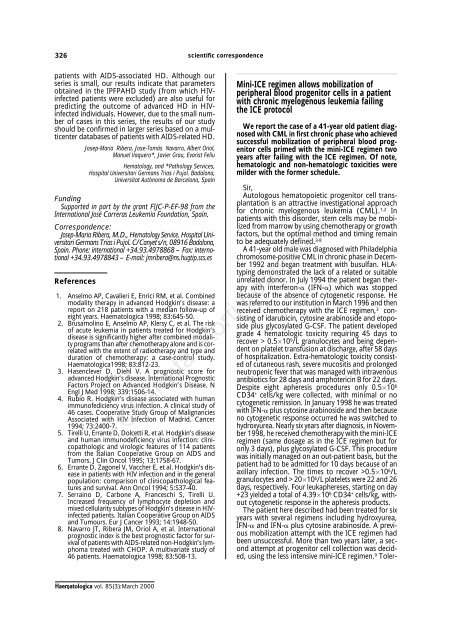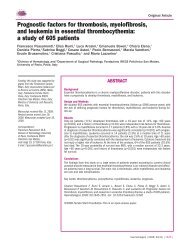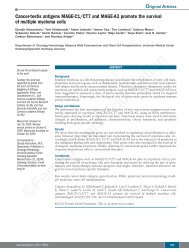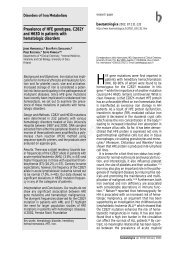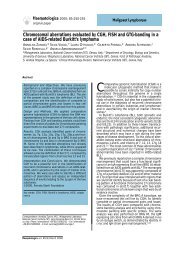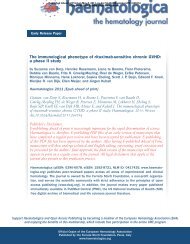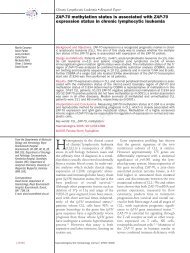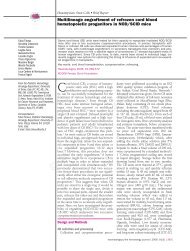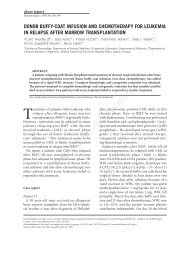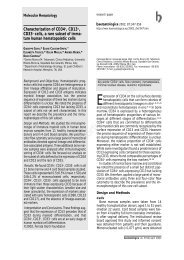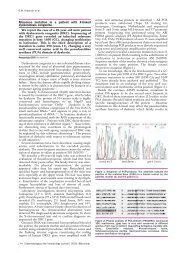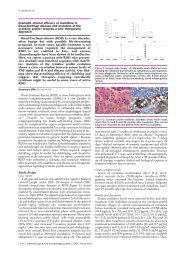Mini-ICE regimen allows mobilization of peripheral blood progenitor ...
Mini-ICE regimen allows mobilization of peripheral blood progenitor ...
Mini-ICE regimen allows mobilization of peripheral blood progenitor ...
Create successful ePaper yourself
Turn your PDF publications into a flip-book with our unique Google optimized e-Paper software.
326<br />
patients with AIDS-associated HD. Although our<br />
series is small, our results indicate that parameters<br />
obtained in the IPFPAHD study (from which HIVinfected<br />
patients were excluded) are also useful for<br />
predicting the outcome <strong>of</strong> advanced HD in HIVinfected<br />
individuals. However, due to the small number<br />
<strong>of</strong> cases in this series, the results <strong>of</strong> our study<br />
should be confirmed in larger series based on a multicenter<br />
databases <strong>of</strong> patients with AIDS-related HD.<br />
Josep-Maria Ribera, Jose-Tomás Navarro, Albert Oriol,<br />
Manuel Vaquero*, Javier Grau, Evarist Feliu<br />
Hematology, and *Pathology Services,<br />
Hospital Universitari Germans Trias i Pujol. Badalona,<br />
Universitat Autònoma de Barcelona, Spain<br />
Funding<br />
Supported in part by the grant FIJC-P-EF-98 from the<br />
International José Carreras Leukemia Foundation, Spain.<br />
Correspondence:<br />
Josep-Maria Ribera, M.D., Hematology Service. Hospital Universitari<br />
Germans Trias i Pujol. C/Canyet s/n, 08916 Badalona,<br />
Spain. Phone: international +34.93.4978868 – Fax: international<br />
+34.93.4978843 – E-mail: jmribera@ns.hugtip.scs.es<br />
References<br />
1. Anselmo AP, Cavalieri E, Enrici RM, et al. Combined<br />
modality therapy in advanced Hodgkin’s disease: a<br />
report on 218 patients with a median follow-up <strong>of</strong><br />
eight years. Haematologica 1998; 83:645-50.<br />
2. Brusamolino E, Anselmo AP, Klersy C, et al. The risk<br />
<strong>of</strong> acute leukemia in patients treated for Hodgkin’s<br />
disease is significantly higher after combined modality<br />
programs than after chemotherapy alone and is correlated<br />
with the extent <strong>of</strong> radiotherapy and type and<br />
duration <strong>of</strong> chemotherapy: a case-control study.<br />
Haematologica1998; 83:812-23.<br />
3. Hasenclever D, Diehl V. A prognostic score for<br />
advanced Hodgkin’s disease. International Prognostic<br />
Factors Project on Advanced Hodgkin’s Disease. N<br />
Engl J Med 1998; 339:1506-14.<br />
4. Rubio R. Hodgkin’s disease associated with human<br />
immun<strong>of</strong>ediciency virus infection. A clinical study <strong>of</strong><br />
46 cases. Cooperative Study Group <strong>of</strong> Malignancies<br />
Associated with HIV Infection <strong>of</strong> Madrid. Cancer<br />
1994; 73:2400-7.<br />
5. Tirelli U, Errante D, Dolcetti R, et al. Hodgkin’s disease<br />
and human immunodeficiency virus infection: clinicopathologic<br />
and virologic features <strong>of</strong> 114 patients<br />
from the Italian Cooperative Group on AIDS and<br />
Tumors. J Clin Oncol 1995; 13:1758-67.<br />
6. Errante D, Zagonel V, Vaccher E, et al. Hodgkin’s disease<br />
in patients with HIV infection and in the general<br />
population: comparison <strong>of</strong> clinicopathological features<br />
and survival. Ann Oncol 1994; 5:S37-40.<br />
7. Serraino D, Carbone A, Franceschi S, Tirelli U.<br />
Increased frequency <strong>of</strong> lymphocyte depletion and<br />
mixed cellularity subtypes <strong>of</strong> Hodgkin’s disease in HIVinfected<br />
patients. Italian Cooperative Group on AIDS<br />
and Tumours. Eur J Cancer 1993; 14:1948-50.<br />
8. Navarro JT, Ribera JM, Oriol A, et al. International<br />
prognostic index is the best prognostic factor for survival<br />
<strong>of</strong> patients with AIDS-related non-Hodgkin’s lymphoma<br />
treated with CHOP. A multivariate study <strong>of</strong><br />
46 patients. Haematologica 1998; 83:508-13.<br />
Haematologica vol. 85(3):March 2000<br />
scientific correspondence<br />
<strong>Mini</strong>-<strong>ICE</strong> <strong>regimen</strong> <strong>allows</strong> <strong>mobilization</strong> <strong>of</strong><br />
<strong>peripheral</strong> <strong>blood</strong> <strong>progenitor</strong> cells in a patient<br />
with chronic myelogenous leukemia failing<br />
the <strong>ICE</strong> protocol<br />
We report the case <strong>of</strong> a 41-year old patient diagnosed<br />
with CML in first chronic phase who achieved<br />
successful <strong>mobilization</strong> <strong>of</strong> <strong>peripheral</strong> <strong>blood</strong> <strong>progenitor</strong><br />
cells primed with the mini-<strong>ICE</strong> <strong>regimen</strong> two<br />
years after failing with the <strong>ICE</strong> <strong>regimen</strong>. Of note,<br />
hematologic and non-hematologic toxicities were<br />
milder with the former schedule.<br />
Sir,<br />
Autologous hematopoietic <strong>progenitor</strong> cell transplantation<br />
is an attractive investigational approach<br />
for chronic myelogenous leukemia (CML). 1,2 In<br />
patients with this disorder, stem cells may be mobilized<br />
from marrow by using chemotherapy or growth<br />
factors, but the optimal method and timing remain<br />
to be adequately defined. 3-8<br />
A 41-year old male was diagnosed with Philadelphia<br />
chromosome-positive CML in chronic phase in December<br />
1992 and began treatment with busulfan. HLAtyping<br />
demonstrated the lack <strong>of</strong> a related or suitable<br />
unrelated donor. In July 1994 the patient began therapy<br />
with interferon-� (IFN-�) which was stopped<br />
because <strong>of</strong> the absence <strong>of</strong> cytogenetic response. He<br />
was referred to our institution in March 1996 and then<br />
received chemotherapy with the <strong>ICE</strong> <strong>regimen</strong>, 3 consisting<br />
<strong>of</strong> idarubicin, cytosine arabinoside and etoposide<br />
plus glycosylated G-CSF. The patient developed<br />
grade 4 hematologic toxicity requiring 45 days to<br />
recover > 0.5�10 9 /L granulocytes and being dependent<br />
on platelet transfusion at discharge, after 58 days<br />
<strong>of</strong> hospitalization. Extra-hematologic toxicity consisted<br />
<strong>of</strong> cutaneous rash, severe mucositis and prolonged<br />
neutropenic fever that was managed with intravenous<br />
antibiotics for 28 days and amphotericin B for 22 days.<br />
Despite eight apheresis procedures only 0.5�10 6<br />
CD34 + cells/kg were collected, with minimal or no<br />
cytogenetic remission. In January 1998 he was treated<br />
with IFN-� plus cytosine arabinoside and then because<br />
no cytogenetic response occurred he was switched to<br />
hydroxyurea. Nearly six years after diagnosis, in November<br />
1998, he received chemotherapy with the mini-<strong>ICE</strong><br />
<strong>regimen</strong> (same dosage as in the <strong>ICE</strong> <strong>regimen</strong> but for<br />
only 3 days), plus glycosylated G-CSF. This procedure<br />
was initially managed on an out-patient basis, but the<br />
patient had to be admitted for 10 days because <strong>of</strong> an<br />
axillary infection. The times to recover >0.5�10 6 /L<br />
granulocytes and > 20�10 6 /L platelets were 22 and 26<br />
days, respectively. Four leukaphereses, starting on day<br />
+23 yielded a total <strong>of</strong> 4.39�10 6 CD34 + cells/kg, without<br />
cytogenetic response in the apheresis products.<br />
The patient here described had been treated for six<br />
years with several <strong>regimen</strong>s including hydroxyurea,<br />
IFN-� and IFN-� plus cytosine arabinoside. A previous<br />
<strong>mobilization</strong> attempt with the <strong>ICE</strong> <strong>regimen</strong> had<br />
been unsuccessful. More than two years later, a second<br />
attempt at <strong>progenitor</strong> cell collection was decided,<br />
using the less intensive mini-<strong>ICE</strong> <strong>regimen</strong>. 9 Toler-
ance was excellent and hematologic and non-hematologic<br />
toxicities were milder than with the <strong>ICE</strong> <strong>regimen</strong>.<br />
Moreover, days <strong>of</strong> neutropenic fever, hospitalization<br />
and consumption <strong>of</strong> antibiotics were reduced.<br />
Unfortunately, no cytogenetic response was obtained.<br />
To date the patient has been transplanted with full<br />
engraftment and no major complications.<br />
Several factors have been associated with the ability<br />
and capacity to mobilize hemopoietic <strong>progenitor</strong><br />
cells in CML such as intensity and type <strong>of</strong> chemotherapy,<br />
time from diagnosis, phase <strong>of</strong> the disease<br />
and previous treatment with IFN-�. 3-8 Our patient<br />
had several <strong>of</strong> these bad prognostic factors in both<br />
<strong>mobilization</strong> attempts. Although more intensive<br />
chemotherapy <strong>regimen</strong>s have been associated with<br />
better <strong>mobilization</strong>, in our patient, the milder mini-<br />
<strong>ICE</strong> <strong>regimen</strong> was associated with successful <strong>mobilization</strong><br />
and with milder hematologic and non-hematologic<br />
toxicities. A similar observation has been<br />
recently reported. 9,10 Furthermore, the mini-<strong>ICE</strong> <strong>regimen</strong><br />
showed no difference in terms <strong>of</strong> cytogenetic<br />
response or <strong>progenitor</strong> yield when compared with the<br />
<strong>ICE</strong> <strong>regimen</strong>. 9,10 Although additional patients are necessary<br />
to confirm our data, they suggest that a second<br />
attempt to mobilize <strong>progenitor</strong> hemopoietic cells<br />
using the well-tolerated mini-<strong>ICE</strong> <strong>regimen</strong> should be<br />
tried in patients who have failed to get benefit from<br />
other intensive chemotherapy <strong>regimen</strong>s.<br />
Antonio Salar, Anna Sureda, Bárbara Menéndez, Jorge Sierra<br />
Clinical Hematology Division,<br />
Hospital de la Santa Creu i Sant Pau, Barcelona, Spain<br />
Key words<br />
Chronic myelogenous leukemia, mini-<strong>ICE</strong> <strong>regimen</strong>, <strong>ICE</strong><br />
<strong>regimen</strong>, <strong>mobilization</strong>, <strong>peripheral</strong> <strong>blood</strong> <strong>progenitor</strong> cells.<br />
Correspondence<br />
Antonio Salar, M.D., Clinical Hematology Division, Hospital<br />
de la Santa Creu i Sant Pau, Sant Antoni Maria i Claret<br />
167, 08025 Barcelona, Spain.<br />
Phone: international +34-93-2919396 – Fax: International<br />
+34-93-2919466 – E-mail: asalar@hsp.santpau.es<br />
References<br />
1. McGlave PB, De Fabritiis P, Deisseroth A, et al. Autologous<br />
transplants for chronic myelogenous leukaemia;<br />
results from eight transplant groups. Lancet 1994;<br />
343:1486-8.<br />
2. O’Brien SG, Goldman JM. Autografting in chronic<br />
myeloid leukaemia. Blood Rev 1994; 8:63-9.<br />
3. Carella AM, Podestá M, Frassoni F, et al. Collection <strong>of</strong><br />
“normal” <strong>blood</strong> repopulating cells during early hemopoietic<br />
recovery after intensive conventional chemotherapy<br />
in chronic myelogenous leukemia. Bone Marrow<br />
Transplant 1993; 12:267-71.<br />
4. Boqué C, Petit J, Sarrá J, et al. Mobilization <strong>of</strong> <strong>peripheral</strong><br />
stem cells with intensive chemotherapy (<strong>ICE</strong> <strong>regimen</strong>)<br />
and G-CSF in chronic myeloid leukemia. Bone<br />
Marrow Transplant 1996; 18:879-84.<br />
5. Johnson RJ, Owen RG, Chiold JA, et al. Mobilization <strong>of</strong><br />
Philadelphia-negative <strong>peripheral</strong> <strong>blood</strong> mononuclear<br />
cells in chronic myeloid leukaemia using hydroxyurea<br />
scientific correspondence 327<br />
and G-CSF. Br J Haematol 1996; 93: 863-8.<br />
6. Chalmers EA, Franklin IM, Kelsey SM, et al. Treatment<br />
<strong>of</strong> chronic myeloid leukaemia in first chronic phase<br />
with idarubicin and cytarabine: <strong>mobilization</strong> <strong>of</strong> Philadelphia-negative<br />
<strong>peripheral</strong> <strong>blood</strong> stem cells. Br J<br />
Haematol 1997; 96: 627-34.<br />
7. Carella AM, Cunningham I, Lerma E, et al. Mobilization<br />
and transplantation <strong>of</strong> Philadelphia-negative<br />
<strong>peripheral</strong>-<strong>blood</strong> <strong>progenitor</strong> cells early in chronic myelogenous<br />
leukemia. J Clin Oncol 1997; 15:1575-82.<br />
8. Mehta J, Mijovic A, Powles R, et al. Myelosuppressive<br />
chemotherapy to mobilize normal stem cells in chronic<br />
myeloid leukemia. Bone Marrow Transplant 1996;<br />
17:25-9.<br />
9. Carella AM, Lerma E, Celesti L, et al. Effective <strong>mobilization</strong><br />
<strong>of</strong> Philadelphia-chromosome-negative cells in<br />
chronic myelogenous leukaemia patients using a less<br />
intensive <strong>regimen</strong>. Br J Haematol 1998; 100:445-8.<br />
10. Sureda A, Petit J, Brunet S, et al. <strong>Mini</strong>-<strong>ICE</strong> <strong>regimen</strong> as<br />
<strong>mobilization</strong> therapy for chronic myelogenous<br />
leukaemia patients at diagnosis. Bone Marrow Transplant<br />
1999; 24:1285-90.<br />
Lamivudine for the prevention <strong>of</strong> hepatitis B<br />
virus reactivation during autologous stem cell<br />
transplantation. A case report<br />
Reactivation <strong>of</strong> hepatitis B virus (HBV) is a frequent<br />
complication during chemotherapy; it may<br />
give rise to hepatitis, hepatic failure and death and<br />
may prevent further chemotherapy from being<br />
administered. We present a case in which the use <strong>of</strong><br />
lamivudine allowed autologous stem cell transplantation<br />
to be performed after a hepatitis flareup,<br />
suggesting a possible role for this drug in preventing<br />
HBV reactivation during chemotherapy.<br />
Sir,<br />
Hepatitis B virus (HBV) reactivation following<br />
chemotherapy withdrawal may result in hepatitis,<br />
hepatic failure and death. 1,2 In fact, immunosuppressive<br />
therapy leads to enhanced viral replication<br />
and to an increased number <strong>of</strong> infected hepatocytes.<br />
Withdrawal <strong>of</strong> the drugs results in partial restoration<br />
<strong>of</strong> immunocompetence with subsequent rapid<br />
destruction <strong>of</strong> hepatocytes. 1 It was recently reported<br />
that nucleoside analogs such as lamivudine (a reverse<br />
transcriptase inhibitor approved for the therapy <strong>of</strong><br />
HIV infection) is effective in suppressing HBV replication<br />
by incorporation <strong>of</strong> its monophosphate form<br />
into DNA, which results in chain termination. 3<br />
We report the case <strong>of</strong> a 40-year old male, known to<br />
be HBsAg positive for 17 years, without any signs <strong>of</strong><br />
active hepatitis, who was diagnosed as having mantle<br />
cell lymphoma (MCL) stage IIIA, in March 1997. He<br />
was treated with six cycles <strong>of</strong> chemotherapy according<br />
to the F-MACHOP protocol 4 between March and July<br />
1997, without any complications.<br />
Thirty days after the end <strong>of</strong> chemotherapy he presented<br />
the full clinical picture <strong>of</strong> an acute hepatitis,<br />
with SGOT at 2,820 U/L, SGPT at 1,525 U/L and<br />
total bilirubin at 14 mg/dL.<br />
HBV-DNA (detected by nested polymerase chain<br />
reaction as described by Kaneko et al. 5 ) was positive<br />
(having been negative before starting chemothera-<br />
Haematologica vol. 85(3):March 2000


